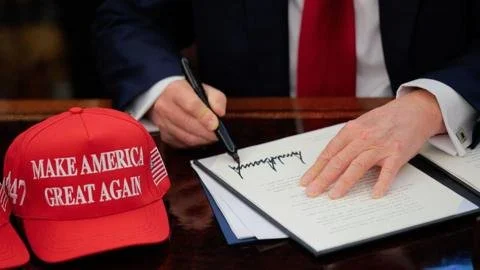Tariffs Unleashed: How Trump's Trade War is Reshaping the American Economy
Since January, President Donald Trump has reignited his tariff agenda, introducing substantial import taxes on goods from various nations while threatening even more. His administration argues that these tariffs are crucial for boosting American manufacturing and protecting domestic jobs. However, this unpredictable approach to international trade has led to significant chaos in the global economy and concerns over rising costs for U.S. consumers.
Tariffs are levies placed on imported goods, calculated as a percentage of the product’s value. For example, a 10% tariff on a $10 item adds an extra $1, transforming the total cost to $11. These taxes are paid by companies bringing foreign goods into the U.S., which may pass these costs to customers or choose to import fewer products. A recent ruling from a U.S. trade court questioned the legality of some of Trump’s tariffs, stating that certain tariffs were imposed under questionable national emergency powers. However, an appeals court allowed the tariffs to remain as legal proceedings continued.
Trump’s strategy aims to reduce the trade deficit, asserting that the U.S. has been unfairly treated by various nations, whom he labels as ”cheaters”. Notable tariffs announced include:
50% on steel and aluminum imports
25% on foreign-made cars and related parts
50% on copper imports starting August 1
Additionally, Trump threatened a 200% tariff on pharmaceutical imports, although specifics remain unclear. The administration labeled roughly 60 trade partners as the ”worst offenders”, setting the stage for higher rates against countries such as the EU and China. Initial deadlines for these tariffs have often been amended or postponed as negotiations proceed.
Negotiation leverage also includes intertwining tariffs with migration and drug enforcement issues, as seen with trade partners like China, Mexico, and Canada. Tariffs on Brazilian, Cambodian, Canadian, and Mexican goods have been communicated, threatening increased levies depending on international cooperation.
In significant developments with the EU, both sides reached an agreement for reduced tariffs, including 15% on European goods like cars while the U.S. also agreed to several new tariffs on imports from Vietnam, the Philippines, and Japan. However, crucially, negotiations with India are ongoing as well, posing additional costs for U.S. importers.
The repercussions of these trade policies have rippled through the stock markets, causing instability, and influencing global economic forecasts. The IMF and OECD have revised their growth predictions downwards, forecasting negative impacts on the U.S. economy. Rising tariffs have already contributed to an uptick in the inflation rate, and businesses are beginning to pass along these costs to consumers, indicating that prices for everyday goods are expected to rise. Companies are adjusting by importing fewer foreign goods, raising the costs of available items, while domestic production costs escalate due to reliance on imported components.
These tariffs have also led to increased customs checks at borders, resulting in delays that could further disrupt supply chains. The evolving trade landscape poses an ongoing challenge for U.S. companies and everyday consumers, as the costs of goods continue to climb and the long-term effects of Trump’s tariffs remain uncertain.

